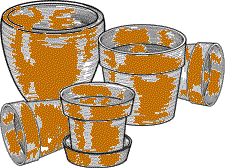|
Container Gardening

Veggies, herbs and fruit can be grown in
containers. This is a great option for people that have a
small or limited area and would like to grow on a patio or in a
sunny window. It's also good way to extend your growing
area and makes it easy to move plants around to take advantage
of sun or shade.
Growing mixes... 1
part sterile, clean sand (play sand)1 part composted cow manure,
1 part milled peat moss and 1 part compost. Mix well and
water, place some gravel or small rocks in the bottom of the pot
to hold in the soil, about 2". Add your mix, plant,
water well and watch them grow!
Water....containers dry out really
rather quickly especially in hot weather. One of the
easiest ways to determine whether your container needs water or
not it to purchase one of those really inexpensive moisture
meters or if the first inch or so is dry it probably needs to be
watered.
Water Quality....the Best to the
Worst..... pond, rain, well water or if all else fails tap
water. Do not use softened water on plants, it will kill
them. Reverse Osmosis is good pure water also, a good
hydroponic nutrient or aquarium supplement should supplement the
watering.
Fertilizer....The more you need to water the
more you are flushing important nutrients out the bottom of the
pot. In hot 90° weather you will need to fertilize with a
good organic fertilizer about every 2 weeks. Only use
organic fertilizers, the non-organic ones can accumulate inside
the pot and weaken the roots. Hydroponic fertilizers
are good, check if they are organic.
Supports....Large plants such as
tomatoes, cucumbers or any others that you are growing vertical
can fall over. Try using large 6' plastic coated metal
supports, stick into the pot all the way to the bottom and out
one of the drain holes into the ground.
Pollination....If you are growing inside, keep
in mind you will not have the pollinators, bees, wasps, etc. and
may need to be done by hand. Lightly shaking the plant or
using a small brush to spread pollen from flower to flower will
work.
Pests.... Inside gardeners
especially...scale and aphids love them. If you get
attacked use insecticidal soap or pyrethrins. Repeated
soaking of weekly should keep the little buggers under control.
Fungus gnats are tiny flies who lay eggs in organic moist soils.
This can be controlled using Bt soil soaks. Works very
well. Outside containers attract slugs, the drain holes
are a really nice moist refuge to hide in during the heat of the
day. You can control with iron phosphate that is available
or I also use plastic plant bottoms and keep water in them.
I grow in the south which is high 90's to 100's during the
summer and can get away with it. If you are in a cooler
climate this is not recommended. Make sure you have a good
layer of rock or clay pellets or perlite down first so the soil
mix is not sitting in the water.
Light....Again for the inside
gardeners...if you want veggies to flower and fruit you must use
HID lighting. Metal halides are specially designed bulbs
that will mimic full spectrum sunlight. In the summer
leave on for 12 hours in the winter 14. There are all
different types of bulbs, the ones you want will go more toward
the red spectrum for flowering. And the outside
gardeners...Keep in mind that most veggies need at least 6 hours
of sunshine to flower and fruit especially in Northern climates.
Heat Buildup... If you are using lights inside
especially halides, they give off a lot of heat. You may
want to consider an addition small air conditioner unit or fan.
Airflow....Also important for growing
inside. A good ceiling fan or other one blowing across the
veggies really helps them stay healthy also and cuts down on
fungus diseases.
Container Size.... Always consider the size of the
root ball of your plant, look at the top and the roots will
should be similar or larger. The larger the plant, the larger
the container.
What Type of Container?.... Plastic will retain
more water than clay. Clay will "breathe" more getting
more air to the roots. Depending on what you want to grow
some are better than others.
|